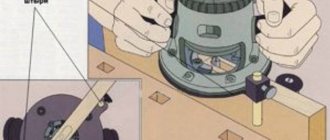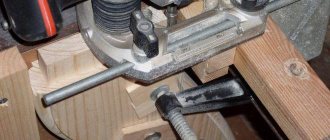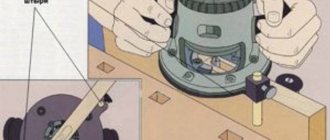Many woodworkers dream of buying the perfect tenoning device for a router in order to quickly and accurately make straight or dovetail tenons. These factory fixtures can do much more than simple box tenons. One example is semi-blind spines (pictured on the right below). Such a device will perform any semi-blind dovetail connection. So what if
If you are familiar with how a conductor works, then you are on your way to mastering this technique. Using the proposed templates in the set, you can make any semi-blind connection and it works in much the same way as in a typical box - only with slight differences. But today, let's look at how to make a device with your own hands that will help you make simple box tenons.
Tenoning attachment for a router with a constant size.
Every carpentry workshop simply needs to have a tenon-cutting device for the router for making tenons of different sizes. When making such a device, you need to understand that it, in this case, is made for one specific size of spikes. It's not difficult to make and it will work like a clock. The necessary parts are guides for making tenons; they are installed on opposite sides of the device body in a checkerboard pattern and at the same distance from each other. A cutter with a thrust bearing is inserted into the hand router, which follows the shape of the guides. If the guides are cut to the same size and evenly mounted into the body of the device, then the tenons will fit together perfectly. These studs measure 7/8″ wide and the stud height is 3/4″. Before making tenons, install the router and cutter on the router table. Note: A situation may arise when a cutter with a thrust bearing is not available, then a guide bushing for the router will correct the situation. Securely secure the device itself with clamps on a 15″ long board.
Milling tenons: easy and fast
However, even a novice carpenter can easily master a connection of any complexity if he uses a special milling device and ready-made templates.
To perform a dovetail joint traditionally by hand - with a tenon saw and chisel - and achieve good results, you need to have certain skills. However, today most woodworkers use special power tools to cut complex tenons and mortises into pieces. These tools can also be used by home craftsmen who would like to decorate their home-made furniture with decorative joints.
A special milling device cuts tenons perfectly accurately if you guide it in a “prescribed course” according to a rigid template attached to the parts. Even coarse-fiber wood can be processed with a milling cutter, and the curly contours of the joining seams on a product made from it look great.
The tenons are cut in the same way using a cutter installed in a drill using a special attachment. In this case, you can design either a simple corner connection with a straight open tenon, or a more complex one - a “dovetail”.
The use of these power tools allows you to process different types of workpieces - both plywood and solid wood.
Making complex corner joints
A comb-like metal plate with clamping fixtures and a hand-operated router are all the equipment needed to make corner joints on a straight open tenon or dovetail. It is extremely simple to guide the cutter along the template: it fits into the part with such precision that even beginners can make tenons flawlessly.
Both types of tenons are cut out on two parts to be joined in one step. The parts are secured with offset metal clamps on both sides.
The lateral edges of the parts are shifted by the width of one tenon to the left or right. If a corner connection is made on a straight open tenon, then both boards are installed vertically. To make a dovetail joint, one board is installed vertically, the other at right angles to the first board.
The cutter is guided along the metal template from left to right. It is necessary to ensure that the working (cutting) part of the cutter does not touch the template itself. Using a milling machine and a template, you can process two boards up to 28 cm wide in one go. The optimal board thickness for making a corner joint on a straight open tenon is from 16 to 20 mm.
Semi-concealed dovetail connection
Today, semi-concealed dovetail joints are almost never made by hand. However, before furniture production was put on stream, this type of corner connection was considered traditional. Most often it can be seen on drawers. A simple device - a compact attachment for a drill - will allow the home craftsman to make a classic semi-concealed dovetail connection.
The attachment allows you to guide the cutter clearly within the boundaries indicated by the metal template, both in the horizontal and vertical planes. As a result, the tenons and grooves are very precise.
To begin with, we recommend that you practice making this connection on discarded pieces of wood to get your hands on it. The drill should operate at a speed of no more than 5000 rpm. This is relatively slow for a drill, but a cutter spinning faster can chip the edges of the part.
Cutting tenons using a milling cutter according to a template
The handle equipped with the drill attachment not only helps guide the cutter. The design of the handle is such that it allows you to change the position of the cutter head and accordingly adjust the depth of the groove, and the fastening contour ensures that the cutter moves along the template with millimeter accuracy.
To make the grooves, the metal template is fixed on the workbench along with the first board. The cutter is directed from top to bottom. If the workpiece is wider than the template, it is shifted. A small plastic pin helps you select the desired position. Then the rest of the board is processed.
Then the second board is placed on the workbench, and the first one is placed on it in order to install and secure the metal template in the desired position (the protrusion on the edge of the template must fit exactly into one of the middle grooves of the first board). As a result, without complex measurements, it is possible to ensure that the tenons and grooves on both parts completely coincide.
When processing the second board, the cutter is directed horizontally. An additional board placed underneath is needed to ensure that the cutter goes through the full thickness of the part.
Grooves If you decide to cut parts for a drawer with a hidden dovetail joint with a milling cutter, then take into account that the blind grooves in such a drawer should be located on the front and back walls, and the tenons should be on the side walls, respectively.
Using the same drill attachment and the same template, you can also make a corner connection to a straight open tenon. To do this, just change the cutter.
Adjustable tenoning jig for router.
How to make grooves in the body of a device for a hand router at ideally equal distances from each other and the same size? We can say that this is a common operation in woodworking and a router is the ideal tool for the job. The grooves can be located widely, as in the example in the photo, or they can be located very close, like box tenons. It doesn’t matter for what purpose the grooves are located, the main thing is that the grooves are evenly spaced - parallel to each other, at the same distance and with the same width. To do this, you need to make a simple device consisting of a piece of MDF on which the router is attached. Such a jig can be made to fit one size or with the ability to adjust the distance between the grooves, as shown in the photo below.
Shiporezka.ru - tools for carpenters!
Hello! I, Yuri Mikhailovich, also known to many carpenters, professional woodworkers and carpentry enthusiasts under the nickname “ Countryman ,” welcome you to my website. For those who don’t know me, I’ll bring you up to date. I provide services for the manufacture of various products for hand milling machines. These high-quality products allow you to turn a hand router into homemade high-level woodworking machines. With my help, my tools for a router, your work with a hand router will bring you joy and pleasure. For example, using plates for installation, attaching a hand router to a table, guides, and a convenient protractor, you can make a homemade milling table for a hand router. And by purchasing an additional tabletop for the milling table, made from high-quality multi-layer CNC-laminated plywood, you will receive a practically complete set of a professional milling table! Moreover, the quality of the plates, protractor, table tops and other accessories of such a milling table will be much higher than many similar “branded” router tables, and the cost is much lower. Such miracles! Here, for example, is one of the many customer reviews: “ I bought it. Well done. I haven't seen the original device, but I assume this one is better. Respect to Yuri (Zemlyak) and many thanks! And if you want, you will find many such reviews! This is not surprising, considering that many unique parts are made on high-tech, state-of-the-art equipment by professionals with a capital P. Here on the website, you can order both individual devices for a manual router and finished products, for example, a tenon cutter - a tenon cutter . This device will allow you to make high-quality tenon joints using a hand router in the manufacture of various products. Starting from the manufacture of simple frames, box joints, the manufacture of beehives and chairs, country and garden furniture, as well as good quality furniture for the home. What is very important is that you can do it yourself. Well, if you are professionally engaged in the manufacture of custom-made furniture, according to individual orders and projects, or make home furniture for the kitchen or living room, offices or shops, you will also find on the site many useful tools for wood processing. With the help of these devices, your carpentry workshop will allow you to produce high-quality furniture for any purpose at a much higher, professional level. All products are made using high-tech equipment for various types of routers and circular saws. Plates for the milling table, bushings for the router, box templates for making tenon joints, tenon cutters and other parts are cut out by laser cutting in precise compliance with all the required dimensions, for each type of router or circular saw. In addition to the products listed on the website, you can order other devices for carpentry. To buy the necessary product, you can use the site’s online store or simply send me an order by email.
Tools used
The creation of tenons and grooves, with the help of which the connection of two wooden blanks will be ensured, involves taking a sample of material on the side surface of a beam or board using a hand router. In this case, all geometric parameters of the elements of the future connection must be strictly maintained.
To perform this operation with a hand router, you can use tools with shanks with a diameter of both 8 and 12 mm. The most universal in this case is a groove cutter, the cutting part of which works as follows:
- the lateral surface forms the walls of the groove and the sides of the tenon;
- the end side processes the bottom of the groove and removes a layer of material of the required thickness from the base of the tenon.
Cutting a tenon with a mortise cutter
Thus, using a tool of this type, it is possible to form both a tenon and a groove on the side surface of a beam or board. Moreover, their sizes can be adjusted within a fairly wide range.
In cases where higher demands are placed on the reliability of the connection of wooden parts, the grooves and tenons are made not of a rectangular shape, but of a shape called “dovetail”. Grooves and tenons of this configuration are created using dovetail cutters. It is also possible to perform the procedure for forming grooves and tenons of this shape with a manual milling cutter, but for these purposes you should use devices of a different design.
Dovetail sampling using a template
So that the question of how to make a groove in a board or beam or a tenon on their side surface does not cause any particular difficulties, it is better to use a power tool equipped with comfortable side handles, a wide guide sole and the option of protecting the spindle from turning during the process of replacing the cutter. In addition, it is desirable that such equipment have a side stopper, due to which the overhang of the cutter used with it will always remain constant.











